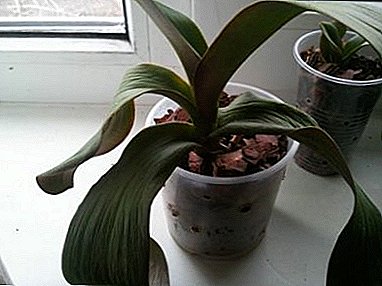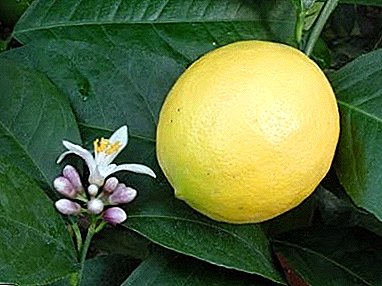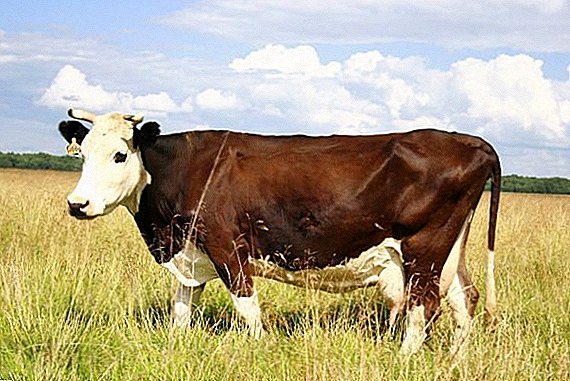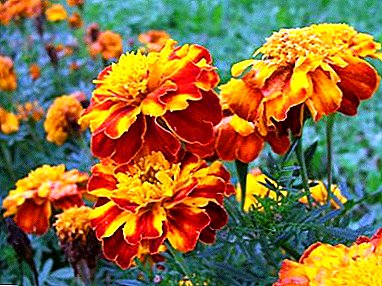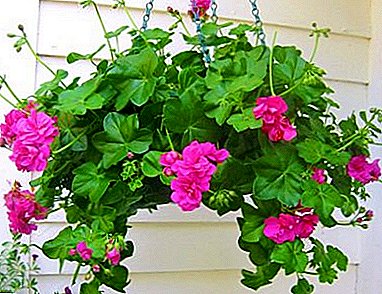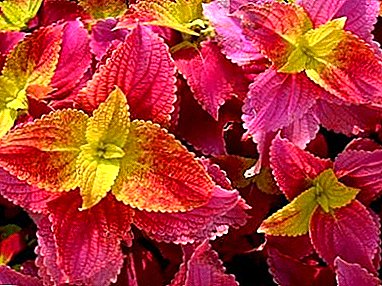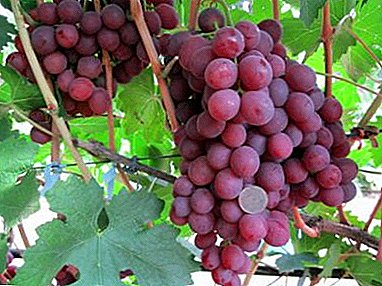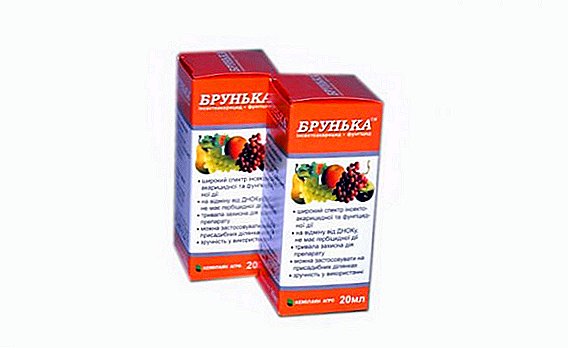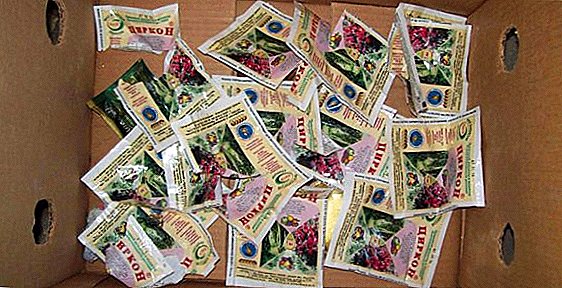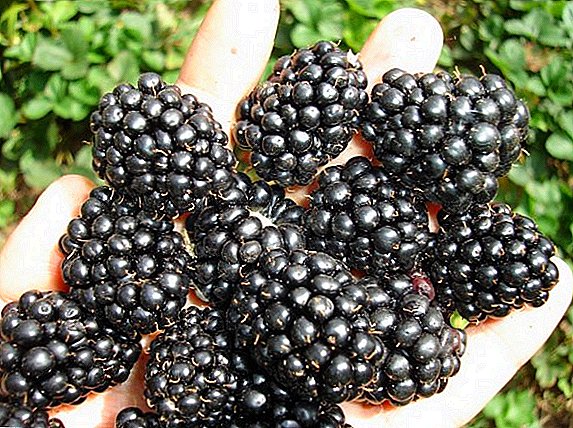 Blackberry enters into the subgenus Rubus of the family Pink. Berry with the mind is very similar to the healing raspberries.
Blackberry enters into the subgenus Rubus of the family Pink. Berry with the mind is very similar to the healing raspberries.
In Europe, blackberry is not grown, but in America it is one of the most relevant berries. Blackberries from Mexico are native, and the entire crop is exported to the USA and Europe.
In our country, the berry bush grows in the wild, but thanks to its healing properties and palatability, the blackberry is gaining popularity in home gardens.
Did you know? Blackberries have a tonic effect for the whole organism.
This article will tell about one of the varieties of blackberry - Tornfri.
Features of a grade of Tornfri
Among other species and varieties of blackberry Tornfri is very recognizable. It has many features:
- Thornfri blackberry bush without thorns. This allows you to calmly pick berries without harming your body.
- Late maturation. Blackberries can be harvested in June, and in August, new berries will be formed.
- Excellent yield. With one bush you can collect about 20 kg of blackberry.

The bush has a lot of branches, and on one of such fruit branches there can be 20-30 berries each. Their shape is oval and slightly elongated. Reaches berries up to 3 cm in length, weight - up to 7 g. They taste sweet with a sour aftertaste and delicate aroma.
Did you know? Blackberry juice has antipyretic properties due to the content of bioflavonoids in it, which contribute to the normalization of the temperature balance of the body.
Planting Blackberry Seedlings
As was already mentioned in the description of the Tornfrey blackberry variety, the berry bush is considered to be a good additional income, since the blackberry harvest is plentiful, and growing and caring for it is not difficult.
Planting blackberries is not a big deal. It all depends on the type and variety of blackberries. But it is also important to follow the rules of planting plants in the garden.
How to choose seedlings
To buy blackberry seedlings Tornfri need to in proven stores for gardeners. It is best to take annual bushes with well developed roots. They should be two stems more than 0.5 cm in diameter. On the roots should already be formed buds. 
When to plant
Landing starts in spring or autumn. In the spring, seedlings are planted when the buds have not yet grown on them, and in the fall it will be better to plant them in early October, before the frosts come, otherwise the blackgrass will not lose its winter hardiness.
How to choose and prepare a place for landing
Blackberry has a weak winter hardiness. Therefore, the landing site should be well lit and warmed up. It is better to protect the blackberry from cold winds. Blackberry demonstrates high yield on fertilized and drained loams.
Important! Blackberries do not tolerate the occurrence of water and waterlogged soils.
Blackberries should not be planted on carbonate soils. The plant will be affected by chlorosis, and this is due to a lack of magnesium and iron. Loams should be medium, with an acidity of 6.0 pH.
The soil for planting is prepared in advance, preferably in the fall. The plot is dug up to a depth of 50 cm, and is introduced into the ground by 1 square meter. m 11 kg of compost, 45 g of superphosphate and 25 g of potash supplements.
How to plant (step by step process of planting)
 The distance between two blackberry bushes should not be less than 1 m. The size of the gap depends on the variety and sprouting. The depth and width of the pit for a blackberry sapling is determined by its age and quality.
The distance between two blackberry bushes should not be less than 1 m. The size of the gap depends on the variety and sprouting. The depth and width of the pit for a blackberry sapling is determined by its age and quality.
We clarify that there are two ways of planting blackberries - tape and bush.
The bush method is as follows: two or three seedlings with a low level of germination are planted in one pit. Place pits according to the scheme 1.8 by 1.8 m.
Tape method next: seedlings with a high level of germination are taken and planted in the ground in a continuous chain. The distance between them should be about 1 m, and between the rows - 2.5 m.
During planting, seedlings are lowered into a hole and straighten the roots in different directions. Then they are filled with fertilized soil, while it must be done so that the kidney, which is located at the base of the stem, is 2-3 cm underground.
Sapling need not completely fall asleep. There should be a small notch below the seat. The soil around the seedlings should be compacted, each of them must be watered with 4 liters of water. After the seedling absorbs water, the excavations are mulched with manure or peat compost.
After planting, new shoots of seedlings are cut to a height of 20 cm above the surface, and the fruit twigs themselves are removed completely.
Did you know? Blackberries in Europe appeared only at the beginning of the XYIII century.
Proper care is the key to a good harvest.
 From good watering, fertilizer and pruning, the yield of blackberry Tornfri is increasing. Growing this berry bush is not easy for new gardeners. The yield of the berry depends on the proper care of the blackberry blessing.
From good watering, fertilizer and pruning, the yield of blackberry Tornfri is increasing. Growing this berry bush is not easy for new gardeners. The yield of the berry depends on the proper care of the blackberry blessing.
Watering features
Without intensive care, the blackberry Tornfrey, though it bears fruit regularly, but the berries shrink. With proper watering, the fruit bush will bring you large and juicy berries.
During the fruiting period, the blackberry needs plenty of watering. It is best to water the plant once a week. For each bush you need to prepare about 20 liters of water.
Important! Excessive moisture leads to root rot.
Blackberry dressing
Top dressing - One of the important steps to achieving a bountiful harvest and increasing the size of the berries. Immediately after planting, you need to pay a lot of time to the blackberry in the first three years.
Timely fertilization with nitrogen fertilizer will bear fruit in the period of yield. To do this, take 15 g of urea or 20 g of ammonium nitrate for a single bush.
 Feeding blackberries in spring held annually. 55 g of ammonium nitrate are added to the fruiting blackberry bush. After loosening, mulch materials are spread on the ground. Layer should be 5 cm.
Feeding blackberries in spring held annually. 55 g of ammonium nitrate are added to the fruiting blackberry bush. After loosening, mulch materials are spread on the ground. Layer should be 5 cm.
In the autumn On top of the mulch, 95 g of superphosphate and 25 g of potassium sulfate are added. Also, after digging the soil with garden forks to a depth of 10 cm, 7 kg of humus are introduced.
Important! Mineral fertilizer is applied exclusively after watering the bush.
Bushes garter
As a support may be suitable pipes or reinforced concrete pillars with a section of 10 cm and a height of about 2.5 m. They are driven into the ground at a short distance from each other. The wire is tensioned at a height of 100 cm.
There are also some of the most common placement bushes.
Fan shaping.
This method is the easiest when fruit-bearing and growing shoots are placed separately. The distance between them should be 1.5 m. In the first season after planting, young shoots are tied to the trellis to support the blackberry by tilting them in one direction.
The following year, new shoots are tied up and sent to the other side, but it depends on the degree of their regrowth. In the fall, old shoots that have already been bearing fruit are pruned and repeat all the steps from the beginning.
Kustov way.
The distance between the plants in this method should be up to 2 m. Next to the bush, they drive in a wooden peg up to 2 m high as a support for the blackberry.
In the spring, the stems, bent in winter, pick up and select from them 5 strong replacement shoots and root shoots within a radius of 30 cm from the bush. These shoots are tied up to a peg at a height of 100 cm. Stems can be tied up by a figure eight, since they will break under strong wind.
The top of the stem, which will bear fruit, can rise no more than 30 cm above the garter, otherwise it may break under the weight of the crop.
Did you know? The homeland of the blackberry is considered to be America. There, this berry grows on almost every household plot.
Harvesting
 When using agrotechnics you can get a record harvest of blackberry Thornfrey.
When using agrotechnics you can get a record harvest of blackberry Thornfrey.
Some gardeners mistakenly pick black berries very early. Such fruits have some bitterness and acid.
For home consumption, the blackberry is harvested after it has fully matured. To determine such fruits is very simple - they are covered with a gray bloom, and when you click on the berry it will be soft.
After harvesting, the berries are removed completely, but they cannot be left in the sun. Otherwise they will begin to blush and bitterness will appear. Keep berries for a long time can not. It is better to eat the part immediately, and another to put on the jam.
With proper care, the yield of blackberry Tornfrey increases, which means that part can not only be eaten or used for jam, but also sold.
Harvesting after harvesting is carried out in several stages. Ripe berries are easily separated from the shoots along with fruit. They are not crumpled during assembly and more transportable than raspberry berries. If you decide to keep the blackberry for a while, you can store them in a refrigerator at zero temperature.
Did you know? The people have a belief that collecting blackberries after September 29 is dangerous for health, as the leaves of this berry marked the devil.
Pruning and shaping the bush
If you want blackberries to remain large, the bushes must be properly and regularly cut.
The best time for pruning is spring. In the autumn you need to get rid of only dry and damaged shoots and branches.
For the formation and trimming bush blackberry use pruner. Cut to 1/3 of the top of the branches.
For the formation you need to choose 3-4 main lashes from which small shoots come. After the side shoots are formed, the main ones need to be shortened to 0.5 m.
After planting, the first pruning is carried out only two years later, and after that the bush should be trimmed annually to maintain the shape of the blackberry.
How to cover blackberry bushes for the winter
 Whatever the frost-resistant blackberry Tornfrey, berry bushes need to be prepared for winter, since at temperatures up to 20 ° below zero they can freeze.
Whatever the frost-resistant blackberry Tornfrey, berry bushes need to be prepared for winter, since at temperatures up to 20 ° below zero they can freeze.
Before shelter it is necessary to cut off all damaged branches. In late November, shoots are removed from the trellis and bend down to the ground. You can fasten them with metal hooks that are driven into the ground.
At the base of the blackberry mulch with a mixture of peat and plant land for 6 cm. This will protect the roots in cold weather.
There are several types of shelters that are most often used by experienced gardeners:
- Using a double layer of non-woven cover (Spunbond, Agrospan or Lutrasil). The width of the canvas should be not less than 1.6 m. The main advantage of such a cover is that it breathes well and allows moisture to pass through.
- Polyethylene film. A very thick shelter is used, since it is considered effective in establishing deep snow cover in the winter period.
- Spruce spruce branches. He breathes well, but this method is suitable for small seating areas.
- Straw or leaf litter is also used to cover non-woven material from inflating.
Did you know? During the ripening period, blackberries change their color several times - they are immediately green, then gradually turn brown, and very ripe ones have a black color.
Blackberry Thornfrey definitely has more advantages than disadvantages. As you already understood, the main thing is to choose the right sapling, to conduct regular watering and to properly feed the plant so that the blackberry will bring you a bountiful harvest.


